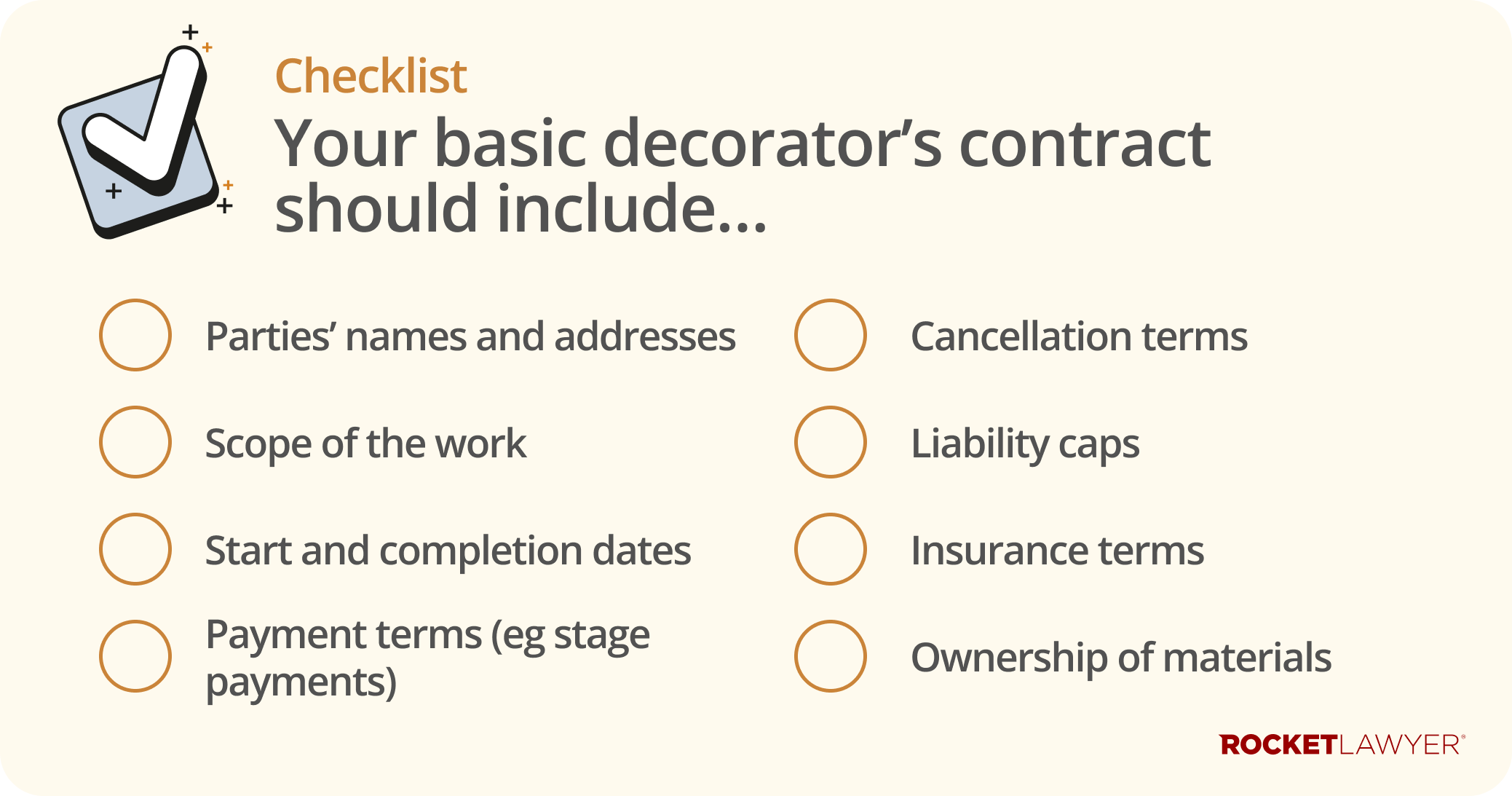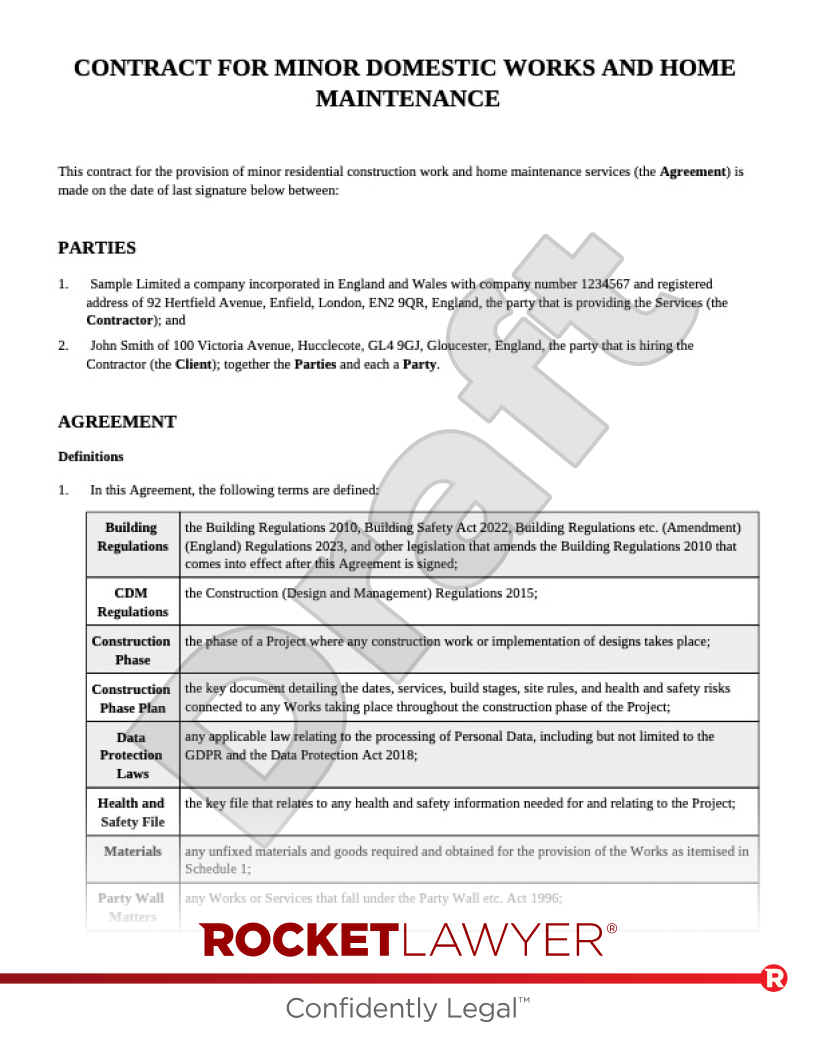Put the basics in writing
Verbal agreements can lead to misunderstandings further down the line, so it is essential that you have a written contract in place that can protect both parties and ensure that everyone understands what has been agreed.
Every contract should include the full names and addresses of both parties, as well as a clear description of the scope of work, including which rooms, surfaces, preparation and finishes have been agreed.
You should also include a start and completion date, making allowance for weather or access issues, and the payment terms - including any deposits, stage payments and when the full balance is due. The contract also needs to include your cancellation terms and how any changes to the work should be handled.
This might sound complicated, but even a short, written agreement or email confirmation will be better than having nothing at all. Trusted resources online have guidance on trade and construction contracts for small businesses that can be useful. It is important to remember that putting things in writing is not about mistrust but about creating a sense of professionalism and clarity.

Liability caps and insurance
We hope that every job you do will be perfect, but this is not always the case and things can go wrong sometimes, so it is important that new decorators take steps to protect themselves. One of the most effective ways to do this is by using liability caps in your contracts.
This is a clause that will limit how much you can be held responsible for in case of general loss or damage, such as stating that it will be capped at the project value rather than being unlimited. This helps to manage your risk levels and show clients that you have thought ahead. However, not all risks and losses can be covered, including personal injury due to any negligence on your part, and any limitations should be reasonable.
There are also some insurance essentials that you will need to have in place:
-
public liability insurance will cover any accidental damage to property or injury to a client or the public
-
employers’ liability insurance is required by law if you have staff apprentices or labourers
-
you have the option to take out professional indemnity insurance for design advice or specialist coatings
Insurance is there to protect both sides as clients can gain range reassurance whilst decorators gain peace of mind.
Service levels and responsibilities
As a decorator, you need to define what quality and professionalism looks like up front. Putting a service level agreement (SLA) or Construction contract in place means that you have written standards of performance, including the finish time frame and clean-up expectations. This gives you the opportunity to state how many coats of paint you will use and whether clean-ups will take place daily or at the end of the project.
Setting these standards will help to avoid any arguments with the client later about what was or was not included. Make sure that you avoid overpromising, as it is better to commit to realistic deadlines and quality that you can maintain. Many professional decorators will refer to The Painting and Decorating Association's Code of Practice when defining their workmanship standards.
Bear in mind, when working for consumers (ie non-business individuals, like home owners) there will always be a base level that any services must be performed with reasonable care and skill, and within a reasonable time frame.
Risk of materials and warranties
It is important to define who is responsible for what when it comes to materials and aftercare. You should confirm in writing who is required to provide the paint, wallpaper or finishes and if this is down to the client and note that you are not responsible for the quality of these or any shortages. If you are supplying them then include details of the brand, product type and agreed finish.
You should also offer a reasonable warranty on your labour, which will typically be six to 12 months for peeling or flaking caused by poor workmanship. You need to make clear that any warranties do not cover fair wear and tear, accidental damage or issues caused by the client’s materials.
When it comes to warranties, you don’t want to overpromise, so it’s best to avoid using words like ‘lifetime guarantee’ unless this is something you can legally uphold. Transparency will help to build trust as your clients will feel protected and decorators can avoid unfair claims.
Payment terms and variations
It is important to set out a clear payment schedule that outlines what deposit needs to be made before the work starts, the stage payments for agreed milestones, and the final balance upon completion and client approval.
You should always confirm any additional work or variations in writing, including extra coats, colour changes or preparatory repairs. Make sure that you provide a quick written quote or Variation agreement to confirm the cost and any time implications - this is especially important when dealing with consumers and adhering to their rights.
This helps to protect everyone as the clients will know the cost up front and decorators are not going to lose money on unplanned work. A clear set of payment terms will help small firms to manage cash flow and reduce disputes. Remember to keep digital copies of any Invoices and receipts for tax and record-keeping compliance.
Resolving disputes
In the event of a dispute, direct communication can solve a lot of problems, so try to discuss the issue calmly and document everything in writing or with photographs. If you can't agree, then consider mediation or conciliation.
For smaller sums, under £10,000, the small claims court offers a straightforward route for resolution and clients can also seek guidance from Citizens Advice or Trading Standards.
If you keep detailed records from day one, it can be much easier to resolve disputes when everything has been documented. Most disagreements arise from unclear expectations, which good contracts and communication can help to prevent.
TL;DR
This insight runs through how decorators can protect their business legally. Your takeaways should be that:
-
the basic terms of your contracts with customers should be in writing to ensure there is no confusion.
-
the basic terms should include parties’ names and addresses, a detailed scope of the work, start and completion dates, detailed payment terms, cancellation terms, liability caps, insurance, material ownership, and warranties.
-
liability caps can help limit your financial responsibility for general loss and damages.
-
you should be realistic about your deadlines and quality, whilst adhering to industry standards, to set clear expectations for customers.
-
when dealing with consumers, be wary of their rights and ensure that you are complying with consumer law in relation to any services provided.
-
it’s best to try and resolve any disputes with direct communication.
-
you should keep as much evidence of services documented to help settle these disputes if they arise.
Contracts and legal safeguards are about protecting your business, your reputation and your clients, so following these steps will help to show professionalism, build confidence with your customers, and keep your business fully protected.





